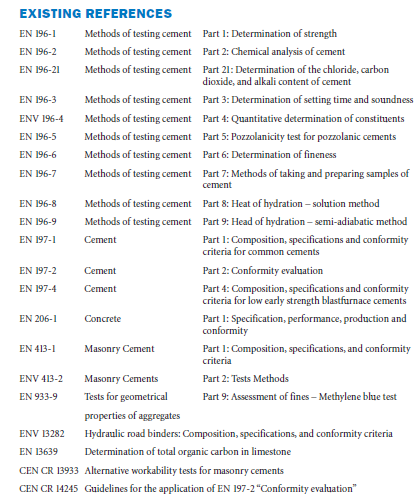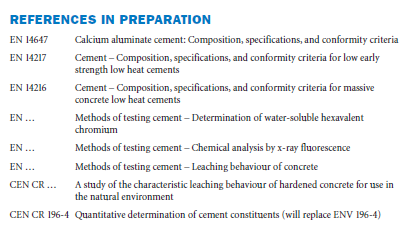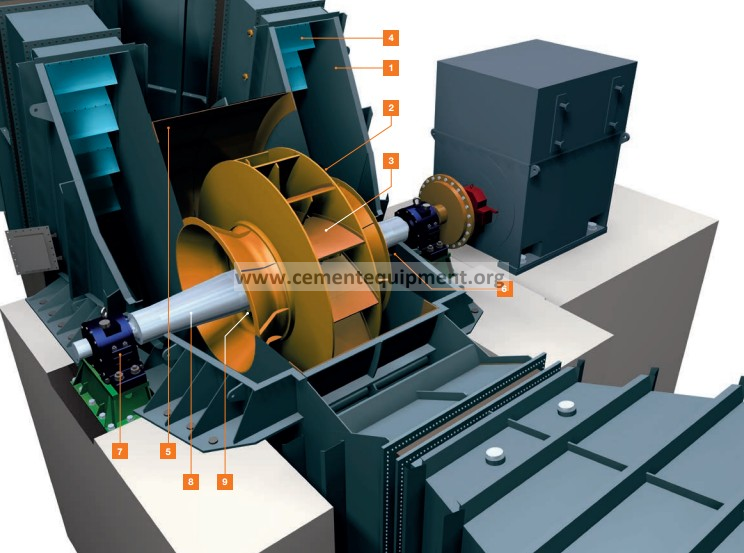Contents
Everything you need to know about European Standards and Specifications for Cements
[wpecpp name=”package” price=”75″ align=”center”]
by Aidan T. Corish* and Beatrix Kerkhoff**
European cement standards are developed by cooperative action among the 28 countries which are members of the European Committee for Standardization (CEN). Europe is responsible for over 250 million tons per annum of cement production. Major cement-producing countries are shown in Figure 9.6.1.
In accordance with the agreement on technical cooperation, “The Vienna Agreement,” between the International Organisation for Standardization (ISO) and CEN, work on cement is undertaken in CEN where the detailed work is entrusted to CEN Technical Committee No. 51 (TC 51). The equivalent ISO activity in ISO TC 74 is dormant as the Vienna Agreement allows CEN Standards to be voted upon in parallel within ISO. Therefore European Standards will be candidate ISO Standards in due course.
The process of standardization involves input from experts from all CEN countries to produce a draft standard which is subject to CEN enquiry. At the end of this enquiry stage, national comments are sub-mitted, together with an indication of likely approval or otherwise. The experts reassemble, consider all the comments, and prepare a document for a final vote. Individual countries decide on a positive or negative final vote (or abstention), and weighted voting rules decide whether or not the standard is acceptable.
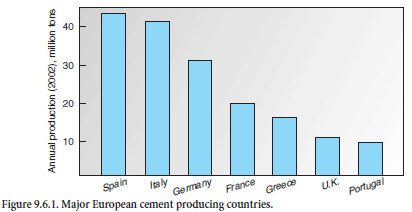
CEN DOCUMENTS
The hierarchy of CEN documents being used in the work of CEN TC 51 is shown in Table 9.6.1.
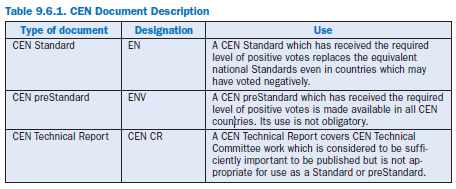
TESTING STANDARDS
Most cement testing standards are in the EN 196 “Methods of Testing Cement” series but other standards are also used. The testing standards in Table 9.6.2 are already in place.
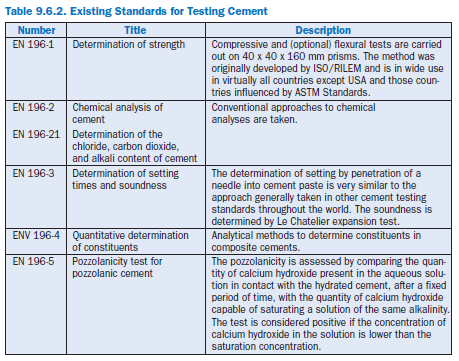
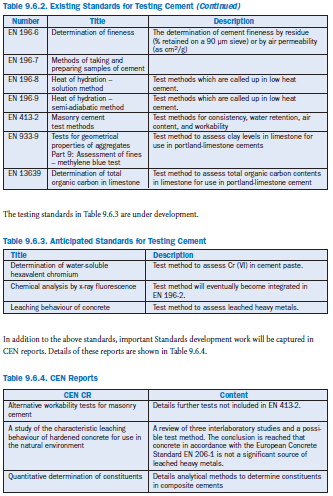
CEMENT SPECIFICATIONS
All cement specifications under development within CEN TC 51 cover composition, specifications, and conformity criteria. As of 2004, work on these standards is almost completed. The status of the various documents is shown in Table 9.6.5.
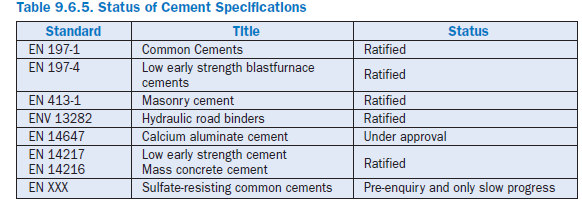
As common cements conforming to EN 197-1 represent more than 95% of European cement production, the remaining special cements are not addressed in detail in information that follows.
Common Cements – Composition
In addition to portland cement clinker (K), the main constituents defined for use in common cements are:
S – Granulated blastfurnace slag D – Silica fume
P – Natural pozzolan
Q – Natural calcined pozzolan V – Siliceous fly ash
W – Calcareous fly ash
T – Burnt shale
L/LL – Limestone
“Minor additional constituents” are also defined and the convention is adopted that the sum of main and minor constituents should add up to 100 when cement composition is defined. In other words, calcium sulfate additions and other additions (grinding aids and the like) are excluded from the compositional calculations.
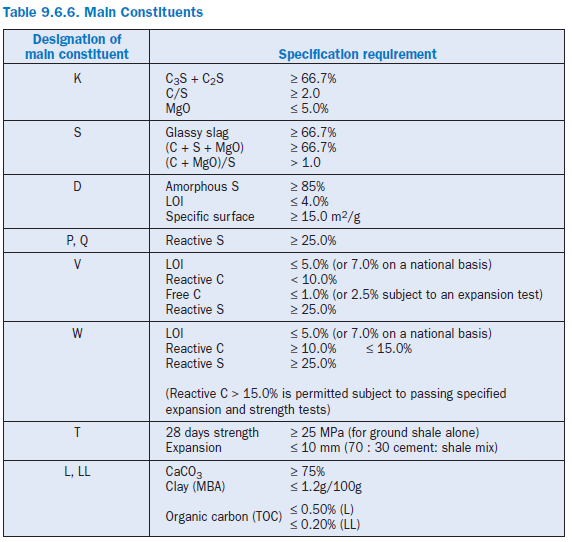
Based on the previously described constituents, 27 different types of common cements are defined in EN 197 as shown in Table 9.6.7.
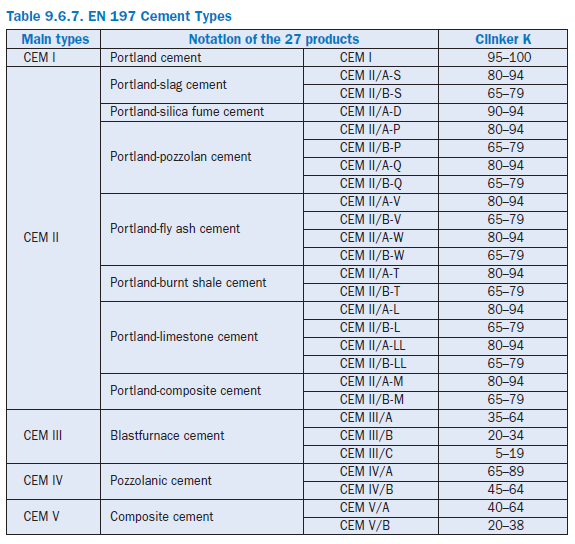
All cements permit up to 5% minor additional constituents. Portland-composite cement, pozzolanic cement, and composite cement permit more than one main constituent but all other types permit only one main constituent.
Common Cements – Mechanical and Physical Requirements
All common cements are required to be sound with an expansion no greater than 10 mm in the Le Chatelier test. Higher strength cements are required to have an initial setting time no faster than 45 minutes and this is extended to 75 minutes for the slower cements. There is no requirement for final setting time. Mechanical requirements are defined in terms of strength classes shown in Table 9.6.8 as follows:
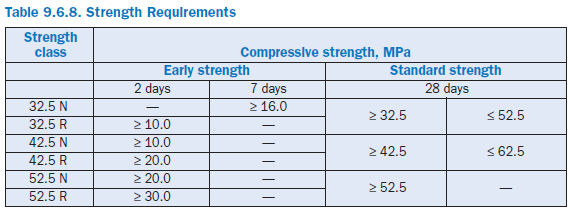
The inclusion of upper as well as lower 28 days strength limits for Strength Classes 32.5 and 42.5 provides effective control of cement variability.
Low heat common cements with heat of hydration values ≤ 270 J/g are covered in EN 197-1 (2004 amendment). Low heat common cements are indicated by LH.
Common Cements – Chemical Requirements
Loss on ignition, insoluble residue, sulfate content (as SO3), and chloride content are all addressed in terms of maximum permitted values. The maximum values may vary depending upon the cement type and/or strength class. The approach taken to sulfate content is of particular interest:
• Most normal strength cements have a 3.5% limit.
• Higher strength cements have a 4.0% limit.
• Exceptionally high slag cements and burnt shale cements have a 4.5% limit.
Pozzolanic cements must also satisfy a test for pozzolanicity.
Common Cements – Standard Designation
CEM cements are identified by cement type (see Table 9.6.7) and strength class (see Table 9.6.8).
Example 1:
Portland cement of strength class 42.5R is identified by: CEM I 42.5R
Example 2:
Blastfurnace cement, containing between 66% and 80% by mass of granulated blastfurnace slag(s) of strength class 32.5N and low heat of hydration is identified by: CEM III/B 32.5N-LH
Common Cements – Conformity Criteria
Conformity of cements to the requirements of EN 197-1 is required to be continually evaluated on the basis of testing of spot samples of cement.
EN 197-1 also defines the frequency of testing and the statistical assessment procedures to be used. As the requirements of EN 197-1 are usually expressed in characteristic terms, there is the added requirement of absolute limits for single test results. For example, for Strength Class 32.5 R, the following apply (MPa):
Absolute minimum strength at 2 days 8.0
Characteristic minimum strength at 2 days 10.0
Absolute minimum strength at 28 days 30.0
Characteristic minimum strength at 28 days 32.5
Common Cements – Certification
Where certification of conformity by a certification body is required (as is generally the case in Europe), the evaluation of conformity is undertaken in accordance with EN 197-2 “Conformity Evaluation.” This standard was voted upon in parallel with EN 197-1 and achieved the same unani-mous positive vote.
It is also the general practice in Europe for audit samples of cement to be independently sampled and tested. The certification body then compares these audit test results with the manufacturers’ own production control test data. The methods of assessing these test data are defined in EN 197-2.
The certification body has the ultimate sanction of withdrawing the manufacturers certificate of conformity if the rules are not adhered to properly.
THE APPLICATION OF EN 197-1 IN EUROPEAN COUNTRIES
EN 197-1 was fully implemented in 2001 and as a consequence all national conflicting standards were withdrawn. Each nation has published the standard separately, such as: BS EN 197-1 in the United Kingdom, DIN EN 197-1 in Germany, and NF EN 197-1 in France.
Informative national forewords and annexes are permitted, but these cannot introduce any addi-tional technical requirements. In the case where options exist, for example in fly ash loss on igni-tion requirement, those countries choosing to accept the higher optional level of loss on ignition would state this in a National Annex.
SPECIAL CEMENTS – FUTURE STANDARDIZATION
It is intended that all special cement standard specifications will follow the model of EN 197-1 and include their own conformity criteria. The standard for conformity evaluation (EN 197-2) has been drafted so that it will be applicable to all future special cements standards.
